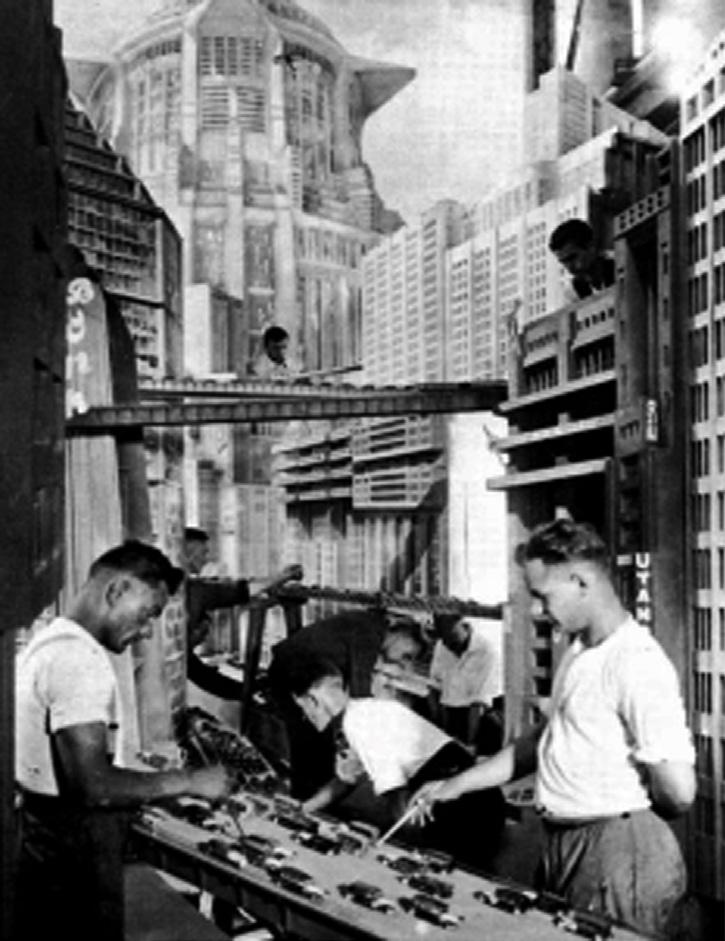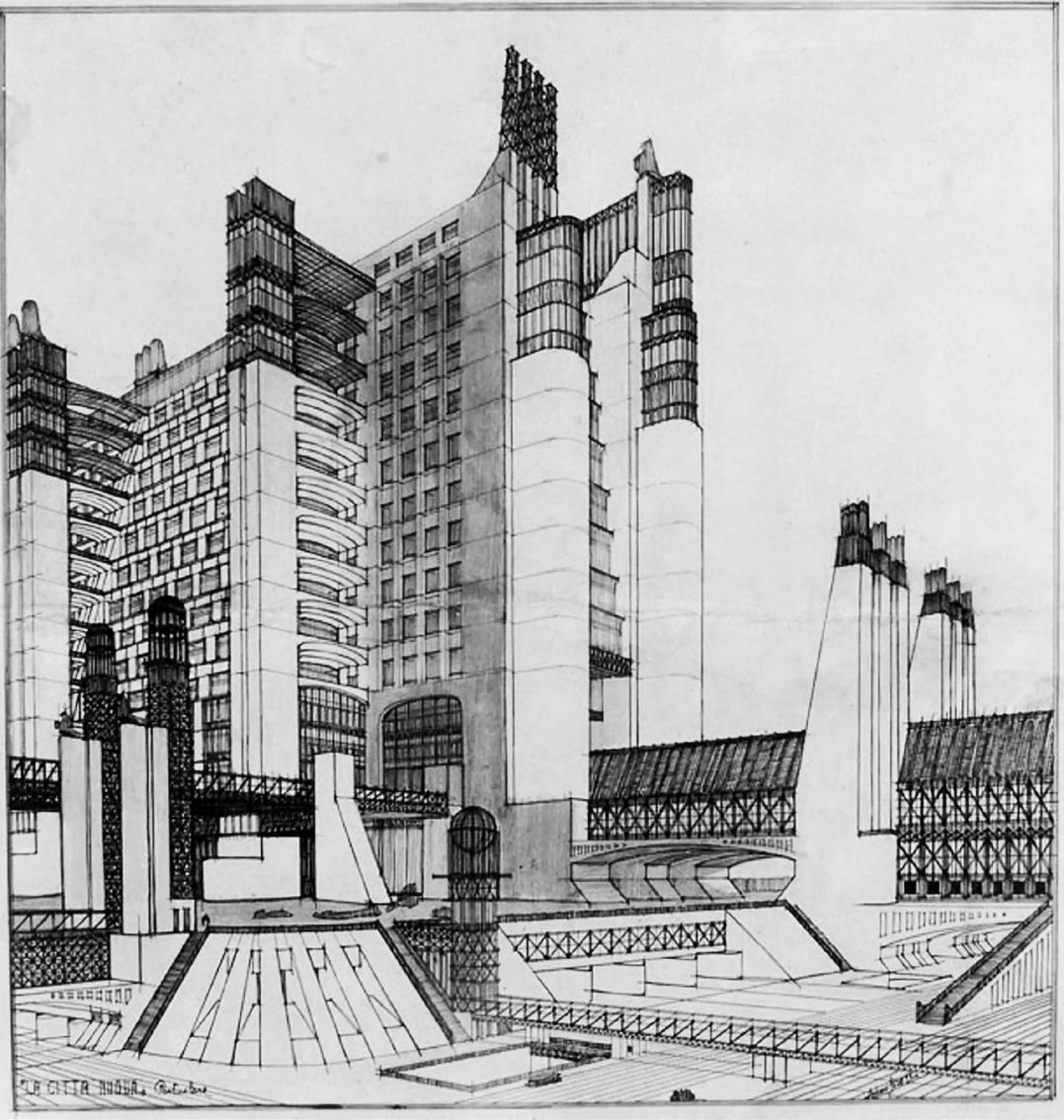
5 minute read
Combination Mapping of Cinematic Architecture
Figure 17
Conclusion 16
Advertisement
This Dissertation aimed to explore how futurist architecture has influenced the sequencing and journey of cinema through its manipulation and control of film sets by introducing factors to direct the movement of characters within each frame. The deconstruction of futurist inspired film throughout time has realised a clear indication that the architecture influences the sequence more so than the sequence influencing the architecture as previously discussed by Carla Molinari. A plethora of Evidence based research supports these claims found from the dissection of framing from various films through a sequential mapping in the style of Bernard Tschumi. Thus, creating the possibility for a comparative analysis of technological inputs and their impact on the dynamic and scaled possibility of the narratives. A further discussion also occurred into the ideological issues each director wished to metaphorically tackle through the futurist re-imagining of each of their current societal position in time.
Throughout this dissertation the ideas of futurist architecture have been analysed confronting the impact they have made onto cinema over the past century. Not only by the input of architectural style but architectural ideals and metaphoric manipulation. Research into the concept of vertical architecture and previous examples of worked plans allowed for the realisation of futurist opinion on utopia and dystopia, one would assume the desires of futurists would aim to create a utopian civilisation which aims to merge all levels of society and create harmony. However, based on findings within this dissertation it could be considered that futurists aimed to design anti-utopias in which they began to dismantle and highlight the reality of where their current societies could be heading. As if the true purpose of the movement was to force a civilization wide realisation of the deep rooted societal issues supported by the government. The contributing factors leading to this conclusion came from the inspection of futurist inspired film and the referral of relevant literature from established resources by other academics.
Continuing from the deconstruction of the futurist movement investigation into the makeup and construction of film sets from Thais (1917) to Blade runner (1982) began to define and understand how the use of structure in cinema controlled the way in which sequencing was presented. Considerations for technological development as a factor for intensity of abstraction throughout the films plus the possibility to create larger more interactive scenes with the use of CGI, like in ‘Robots of Brixton’, were made when discussing how each film differs and whether these differences have improved or restricted cinema. As a concluding note to this point the original futurist film, while influential in its content, is extremely limited to smaller sets causing the scenes to become more enclosed. However, one could then say that due to this factor it allowed for Prampolini to increase the power of his abstracted geometric shapes to form a greater level of futurist influence over the sequences. The journey it proposes is so involved with the architecture the viewer becomes lost in the spiralling decent of structure. That is not to say the films that followed lacked in their abstraction or connections to futurism, on the contrary, they allowed for the witness to become just as immersed if not more so within the spaces no matter how restricted or controlled they became by the architecture.
A Further way in which the sequencing was explored was through a comparative combination mapping of all films discussed within this dissertation (figure 16). By creating figure 16 it allowed for a direct comparison of both the scale of architectural input but also the similarities through which each director has used structure. Taking a closer look, it can be seen that ‘Robots of Brixton’, ‘Thais’ and ‘Metropolis’ all used a similar sharp solid void within their sequencing to show entrapment or control. This also allowed for a further evidenced physical view of the similarities between each of them highlighting the side in which this dissertation has leant after critical analyses of the cinema. That side would be towards the idea that architecture does influence the sequencing in film. However, it cannot conclude on the fact that it influences all aspects and parts of the sequences as evidenced in Scott’s Blade Runner due to the frame controlled by the overpopulated streets of civilians. One could then also begin to form a passive argument when comparing the arguments of Carla Molinari in her paper Sequences in architecture: Sergei Ejzenštejn and Luigi Moretti, from images to spaces of architecture being the aspect influenced by the sequence, she discussed this when breaking down the Baldachin standing within the Basilica and the journey of faces it creates. While it can be seen as evident that architecture may be influenced or may have been influenced by the architect’s vision of sequence it does not seem to parallel that of filmic architecture. Cinematic architecture due to the evidence researched can be concluded to be manipulating the sequence of which it sits.
Bibliography 17
Berghaus, G., Pietropaolo, D. and Sica, B. (2018). 2018. [online] Google Books. Walter de Gruyter GmbH & Co KG. Available at: https://www.google.com/books/edition/2018/YK9VDwAAQBAJ?kptab=editions&sa=X&ved=2ahUKEwi8sPCW1Pb7AhXTnFwKHXpyALoQmBZ6BAgJEAc [Accessed 9 Dec. 2022].
Bould, M. (2019). Afrofuturism and the archive: Robots of Brixton and Crumbs. Science Fiction Film and Television, [online] 12(2), pp.171–193. Available at: https://muse.jhu.edu/pub/105/article/729411/pdf [Accessed 12 Dec. 2022].
Byrne, D. (2003). The Top the Bottom and the Middle: Spaces, Class and Gender in Metropolis. [online] Gale Literature Resource Center. Available at: https://go-gale-com.leedsbeckett.idm.oclc.org/ps/ retrieve.do?tabID=T001&resultListType=RESULT_LIST&searchResultsType=SingleTab&hitCount=1&searchType=AdvancedSearchForm¤tPosition=1&docId=GALE%7CA117772762&docType=Critical+essay&sort=RELEVANCE&contentSegment=ZLRC-MOD1&prodId=LitRC&pageNum=1&contentSet=GALE%7CA117772762&searchId=R1&userGroupName=lmu_web&inPS=true [Accessed 14 Dec. 2022].
Deutelbaum, M. and Neumann, D. (1997). Review of Film Architecture: Set Designs from Metropolis to Blade Runner. Film Criticism, [online] 21(3), pp.115–119. Available at: https://www.jstor.org/stable/ pdf/44018889.pdf?refreqid=excelsior%3A54c2a4b2a88616d71aecd3d1b2b0d723&ab_segments=&origin=&acceptTC=1 [Accessed 13 Dec. 2022].
James Stevens Curl (2018). Making Dystopia. Oxford University Press.
Jukes, T.H. (1971). Overpopulation. Science, 173(3996), pp.475–475. doi:10.1126/science.173.3996.475.b. Kellner, D., Leibowit, F. and An, M. (1984). "Blade Runner J MP C A REVIEW OF CONTEMPORAR MEDIA Blade R nner A diagnostic critique. Jump Cut, (29), pp.6–8.
Luzzi, J. and Carey, S. (2020). Italian Cinema from the Silent Screen to the Digital Image. [online] Google Books. Bloomsbury Publishing USA. Available at: https://books.google.co.uk/books?id=sKTODwAAQBAJ&lpg=PT275&ots=zHsLO2ldGb&dq=Thais%20Anton%20Giulia%20&lr&pg=PT275#v=onepage&q&f=false [Accessed 5 Dec. 2022].
Ma, N. (2017). Emergence of a utopian vision of modernist and futuristic houses and cities in early 20th century. IOP Conference Series: Earth and Environmental Science, 61, p.012033. doi:10.1088/17551315/61/1/012033.
Marcus, M. (1996). Anton Giulio Bragaglia’s ‘Thais’; or, The Death of the Diva + The Rise of the Scenoplastica = The Birth of Futurist Cinema. South Central Review, 13(2/3), p.63. doi:10.2307/3190372.
Mauro, V. and Di Taranto, C. (1990). UTOPIA. IFAC Proceedings Volumes, 23(2), pp.245–252. doi:10.1016/ s1474-6670(17)52678-6.
Minden, M. and Bachmann, H. (2002). Fritz Lang’s Metropolis: Cinematic Visions of Technology and Fear. [online] Google Books. Camden House. Available at: https://books.google.co.uk/books?hl=en&lr=&id=oyOO_HNw0KQC&oi=fnd&pg=PR7&dq=metropolis+set+construction+fritz+lang&ots=i_XJihwns3&sig=u7r6K4KqaRv_HDxUK-EMpmttSXY&redir_esc=y#v=onepage&q=Set%20&f=false [Accessed 16 Dec. 2022].
Molinari, C. (2021). Sequences in architecture: Sergei Ejzenštejn and Luigi Moretti, from images to spaces. The Journal of Architecture, 26(6), pp.893–911. doi:10.1080/13602365.2021.1958897.
Moretti, L., Bucci, F. and Mulazzani, M. (2002). Luigi Moretti: Works and Writings. [online] Google Books. Princeton Architectural Press. Available at: https://www.google.com/books/edition/Luigi_Moretti/mCv5duNe2-kC?kptab=editions&sa=X&ved=2ahUKEwj-iee34_b7AhV4TkEAHQaeBScQmBZ6BAgHEAo [Accessed 11 Dec. 2022].
Moylan, T. and Baccolini, R. (2013). Dark Horizons: Science Fiction and the Dystopian Imagination. [online] Google Books. Routledge. Available at: https://books.google.co.uk/books?id=YoREAgAAQBAJ&lpg=PA233&ots=0Qs4cm6RTH&dq=What%20is%20dystopia%20&lr&pg=PR4#v=onepage&q=What%20 is%20dystopia&f=false [Accessed 7 Dec. 2022].
Notaro, A. (2000). Futurist Cinematic Visions and Architectural Dreams in the American Modern(ist) Metropolis. Irish Journal of American Studies, [online] 9, pp.161–183. Available at: https://www.jstor.org/stable/ pdf/30002693.pdf?refreqid=excelsior%3A4efba75ebc57436f9f976d6678c8df9c&ab_segments=&origin=&acceptTC=1 [Accessed 13 Dec. 2022].
Official Syd Mead Website 2021. (2020). Biography 1933-2019. [online] Available at: https://sydmead.com/ biography/.
Re, Lucia. (2008). Futurism, Film and the Return of the Repressed: Learning from Thaïs. MLN, 123(1), pp.125–150. doi:10.1353/mln.2008.0054.
Russell, E. (2009). Trans/forming Utopia: Looking Forward to the End. [online] Google Books. Peter Lang. Available at: https://books.google.co.uk/books?hl=en&lr=&id=f9z0DYQV6G8C&oi=fnd&pg=PA175&dq=Metropolis+fritz+lang+garden+&ots=mvJg-ravdc&sig=G4ZInIVWwVopgijeiR6ii4LxlBI&redir_esc=y#v=onepage&q=garden&f=false [Accessed 18 Dec. 2022].
Sadowski, P. and Lang, F. (2000). Film and high-rise architecture: the vertical metaphor in Fritz Lang’s Metropolis (1927) THE FUTURISTIC TOWER OF BABEL. [online] Mansell Publishing, pp.1890–1940. Available at: http://www.tara.tcd.ie/bitstream/handle/2262/79222/Sadowski%20Metropolis%20poster.pdf?sequence=1 [Accessed 8 Dec. 2022].
Umbro Apollonio (2001). Futurist manifestos. Boston, Ma: Mfa Publications. Williams, D.E. (1988). Ideology as Dystopia: An Interpretation of Blade Runner. International Political Science Review, [online] 9(4), pp.381–394. doi:10.1177/019251218800900406.
Yuen, W.K. (2000). On the Edge of Spaces: ‘Blade Runner’, ‘Ghost in the Shell’, and Hong Kong’s Cityscape. Science Fiction Studies, [online] 27(1), p.8. Available at: https://www.jstor.org/stable/pdf/4240846. pdf?refreqid=excelsior%3A069675c0742758c9c7886ded5af139eb&ab_segments=&origin=&acceptTC=1 [Accessed 15 Dec. 2022].




